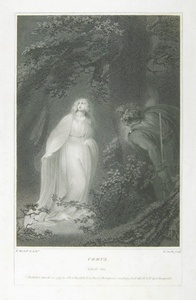| Method | Stipple engraving |
| Artist | Benjamin Smith after Richard Westall |
| Published | Publish'd March 25. 1797, by J.&J. Boydell, & G. Nicol, Shakspeare Gallery, Pall Mall; & No. 90, Cheapside. |
| Dimensions | Image 214 x 148 mm, Sheet 377 x 275 mm |
| Notes |
An illustration of Milton's A Mask presented at Ludlow Castle, 1634, better known as Comus after its principle antagonist, from John and Josiah Boydell's The Poetical Works of John Milton (1794-1797). The heroine of the masque, known only as Lady, has been left alone in the woods while her brothers search for assistance. Her virtue and chastity are depicted by her radiance, in contrast to the gloom that pervades the rest of the scene. Her would-be seducer, Comus, the personification of revelry, watches her from behind a tree, disguised as a villager and carrying a staff of necromantic power. The publication of Boydell's Milton followed the success of his Shakespeare Gallery, and included 28 plates by Richard Westall after works by Henry Fuseli. Fuseli, one of the Shakespeare Gallery's key contributors, had been inspired by Boydell's success, subsequently painting 40 large-scale scenes from Paradise Lost that he intended to form the core of his own 'Milton Gallery'. Richard Westall RA (2nd January 1765 - 4th December 1836) was a British painter, illustrator, printmaker, and drawing master, best known for his portraits of Lord Byron, and his work as a painter for John Boydell's Shakespeare Gallery, and Henry Fuseli's failed Milton Gallery. Benjamin Smith (1754-1833) was a British engraver, printseller, and publisher. A student of Francesco Bartolozzi, his most celebrated engravings were the series he undertook for Boydell's editions of Shakespeare and Milton, though he also produced many fine plates after William Hogarth and George Romney, as well as portraits of George III. Ex. Col.: Hon. Christopher Lennox-Boyd, collector's mark on verso. |
| Framing | unmounted |
| Price | £75.00 |
| Stock ID | 36283 |

